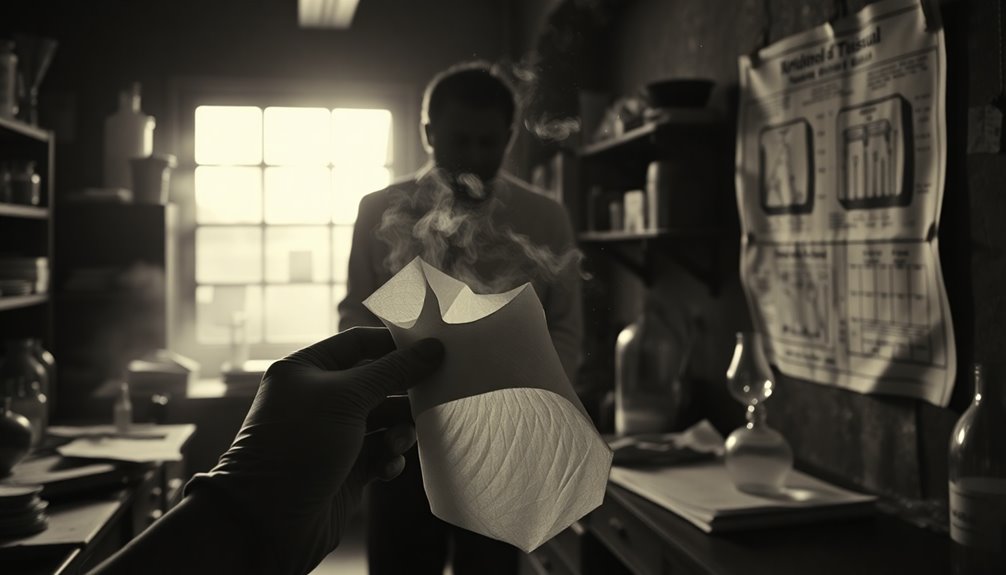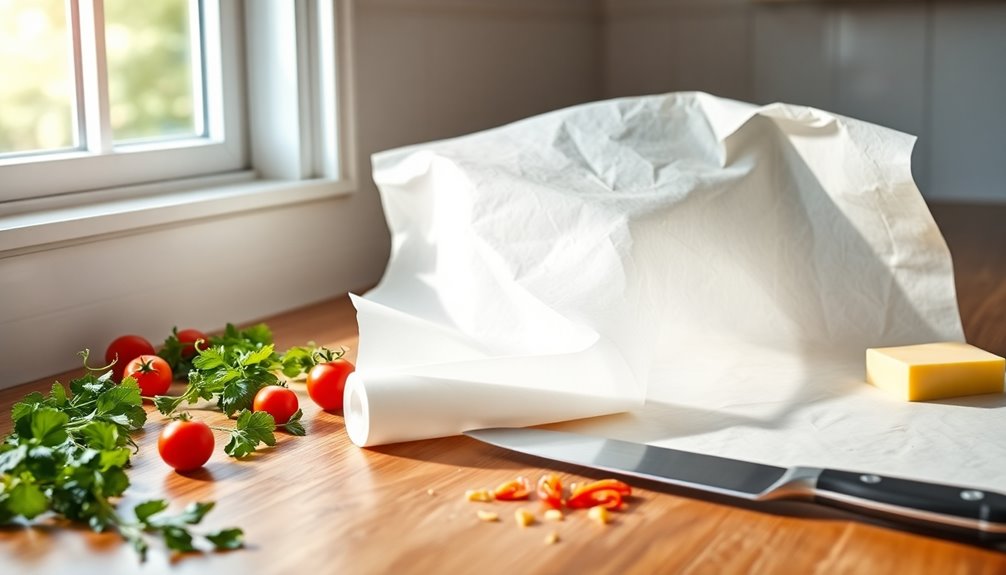Acid-free tissue is a must for preserving valuable items, protecting them from acid migration that can cause yellowing and degradation. Its neutral pH safeguards delicate fabrics, ensuring they remain intact over time. When you wrap photographs or heirlooms in acid-free tissue, you're providing crucial cushioning that prevents abrasion and deterioration. Plus, it's lightweight, breathable, and eco-friendly. Using non-acid-free materials can lead to costly restoration. So, making the switch to acid-free tissue isn't just smart—it's essential for longevity. If you're curious about other strategies for preserving your treasures, there's plenty more to discover.
Key Takeaways
- Acid-free tissue paper prevents acid migration, reducing yellowing and degradation of valuable items over time.
- It maintains a neutral pH, safeguarding delicate fabrics and preventing deterioration of textiles.
- The lightweight and breathable nature of acid-free tissue reduces moisture accumulation and protects against dust and pollutants.
- Using acid-free materials is essential for preserving vintage photographs and heirlooms, preventing irreversible damage and color fading.
- Improper storage with non-acid-free materials can lead to costly restoration and diminish the value of valuable items.
Essential for Preserving Heirlooms
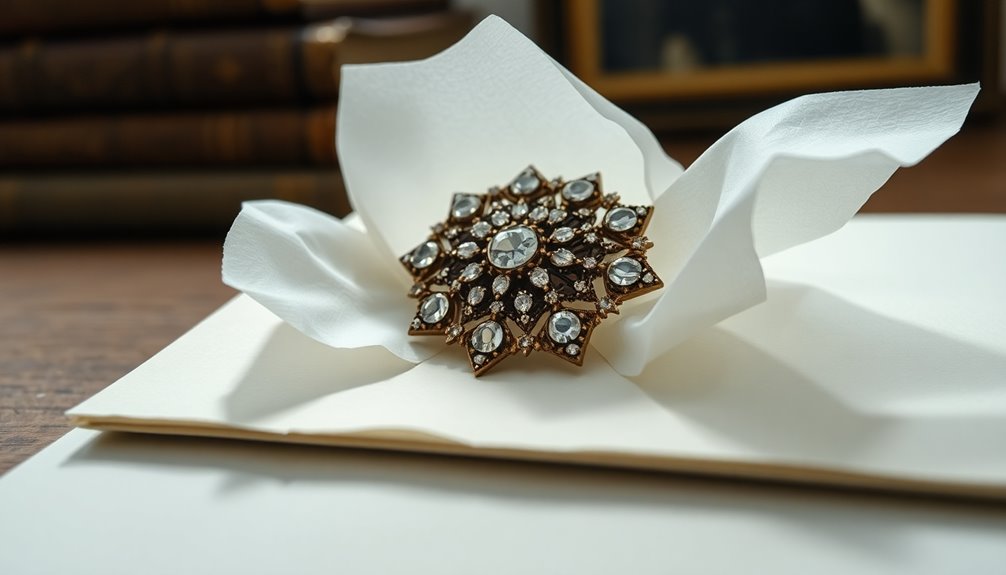
When it comes to preserving heirlooms, using acid-free tissue paper is absolutely essential. This specialized paper prevents acid migration, a common issue that leads to yellowing and degradation of your valuable items over time. The neutral pH of acid-free tissue paper ensures that delicate fabrics and materials, like vintage clothing and textiles, maintain their original condition.
When you wrap your heirlooms in acid-free tissue paper, you significantly reduce the risk of color transfer between garments. This is especially important when dealing with multi-colored items. Additionally, acid-free tissue paper is lightweight and breathable, allowing the stored items to "breathe." By doing so, it minimizes moisture accumulation and helps prevent mold growth.
For long-term storage, acid-free tissue paper is vital. It creates a protective barrier against environmental factors that might cause deterioration. Whether you're keeping cherished family heirlooms or valuable antiques, using acid-free tissue paper ensures their integrity over time. By taking this simple step, you can preserve your treasured items for future generations, allowing your family's history to endure without compromise.
Chemical-Free Preservation Method

Acid-free tissue paper offers a chemical-free preservation method that's essential for protecting your most cherished items. When you choose acid-free tissue paper, you're ensuring that it's manufactured without harmful chemicals and has a neutral or alkaline pH level. This prevents degradation, allowing your valuable documents and artifacts to remain in pristine condition over time.
The absence of acids like lignin and sulfur means your items won't yellow or become brittle, providing long-term protection. Buffered acid-free tissue paper, enriched with alkaline substances like calcium carbonate, further enhances its protective qualities by neutralizing any acids that might be present.
This chemical-free preservation method is particularly ideal for storing delicate items such as photographs, textiles, and important documents. By minimizing the risk of color transfer and degradation, you're safeguarding the integrity of your belongings. Plus, acid-free tissue paper is eco-friendly—being recyclable and compostable, it promotes sustainable practices while ensuring the safety of your valuable items during storage.
Incorporating acid-free tissue paper into your storage routine is a wise choice for anyone looking to preserve the past for future generations.
Storing Vintage Photographs Safely
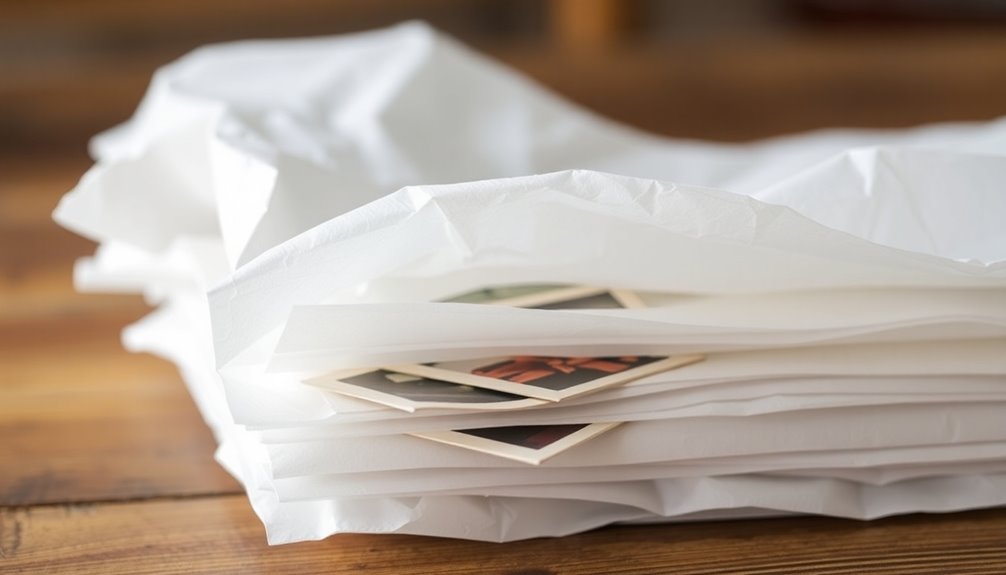
To keep your vintage photographs safe, using acid-free tissue paper is crucial. This type of tissue prevents acid migration that can cause yellowing and deterioration over time. Unlike regular tissue paper, which often contains harmful acids and dyes, acid-free tissue paper has a neutral pH that helps maintain the integrity of your photos, ensuring they remain vibrant and free from brittleness.
When storing vintage photographs, it's essential to wrap each photo individually in acid-free tissue paper. Placing layers of this protective material between each photograph provides cushioning and guards against abrasion as well as environmental factors. This method not only protects the images from physical damage but also ensures they won't suffer chemical deterioration.
For best results, store your wrapped photographs in a cool, dry environment. Regularly check for any signs of damage or deterioration, as early detection can help preserve their condition. By choosing acid-free tissue paper for storing vintage photographs, you're making a wise investment in their longevity, keeping your cherished memories safe for years to come. Remember, protecting your photographs today means preserving your history for tomorrow.
Advantages and Disadvantages Explored
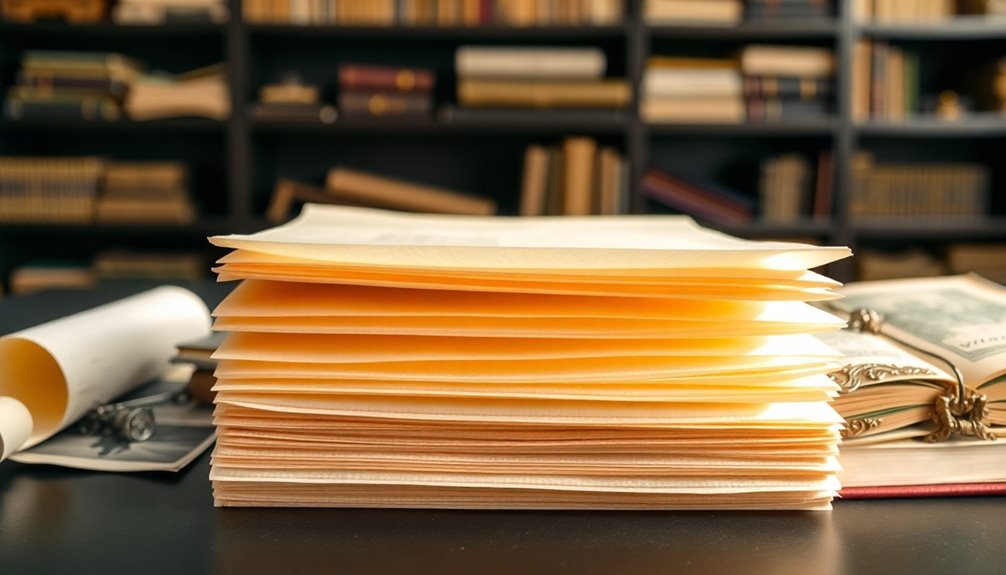
Using acid-free tissue paper offers several significant benefits, especially for preserving valuable items like vintage photographs and delicate textiles. Its neutral or alkaline pH prevents yellowing and brittleness, ensuring your cherished items remain in pristine condition. When you're storing wedding dresses or vital documents, this type of tissue provides cushioning and prevents acid migration, enhancing the longevity and integrity of your treasures.
However, there are some disadvantages to consider. Acid-free tissue paper tends to be pricier than regular tissue paper, which might deter some from making the investment, even though its superior preservation qualities justify the cost for valuable items. Additionally, while it protects against deterioration, proper storage is crucial. If exposed to humidity, acid-free tissue can become a breeding ground for mold, compromising its protective features.
Ultimately, your commitment to sustainability can also guide your choice. By opting for acid-free tissue paper, you're not only preserving your valuable items but also supporting environmentally friendly practices, as its manufacturing process eliminates harmful chemicals. Balancing these advantages and disadvantages will help you make informed decisions for your treasured belongings.
Museum Artifact Preservation Efforts
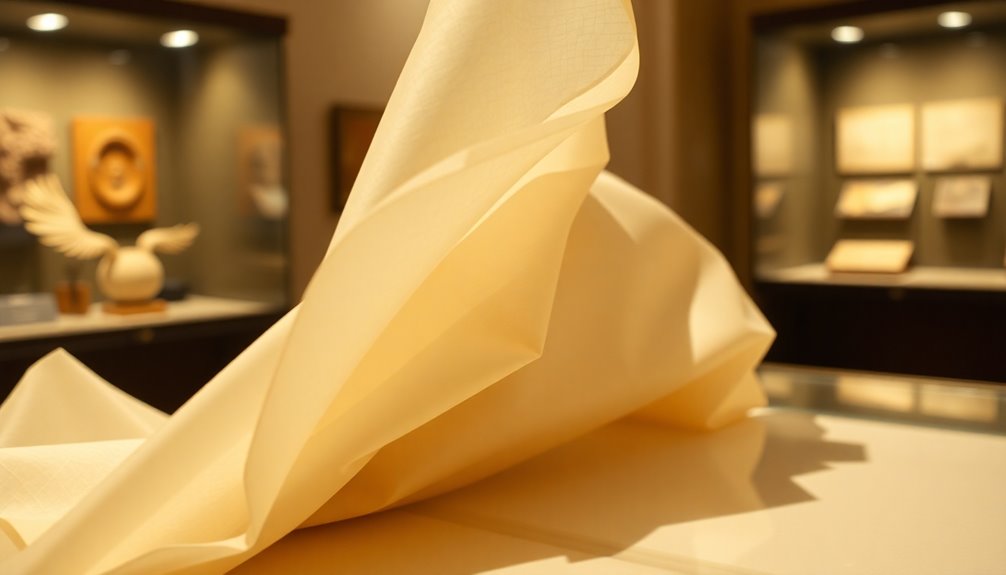
Preserving museum artifacts requires meticulous attention to detail, and acid-free tissue paper plays a pivotal role in these efforts. This material helps prevent deterioration of valuable documents and artifacts by maintaining a neutral pH. By doing so, it inhibits yellowing and brittleness over time, ensuring that historical items remain intact for future generations.
When wrapping sensitive items, acid-free tissue provides a protective barrier that prevents acid migration, which can cause irreversible damage. This is especially crucial for textile collections and delicate documents. Institutions often standardize the use of acid-free materials in their preservation efforts, adhering to guidelines set by organizations like the American Institute for Conservation (AIC).
Additionally, acid-free tissue paper is essential for interleaving and cushioning delicate objects during storage or display. It minimizes physical abrasion and protects against environmental exposure. Regular inspections of museum collections, combined with the use of acid-free materials, are vital to maintain the longevity and integrity of these artifacts. By prioritizing these practices, you contribute to safeguarding invaluable pieces of history, ensuring they can be appreciated by future generations.
Long-Lasting Protection for Textiles
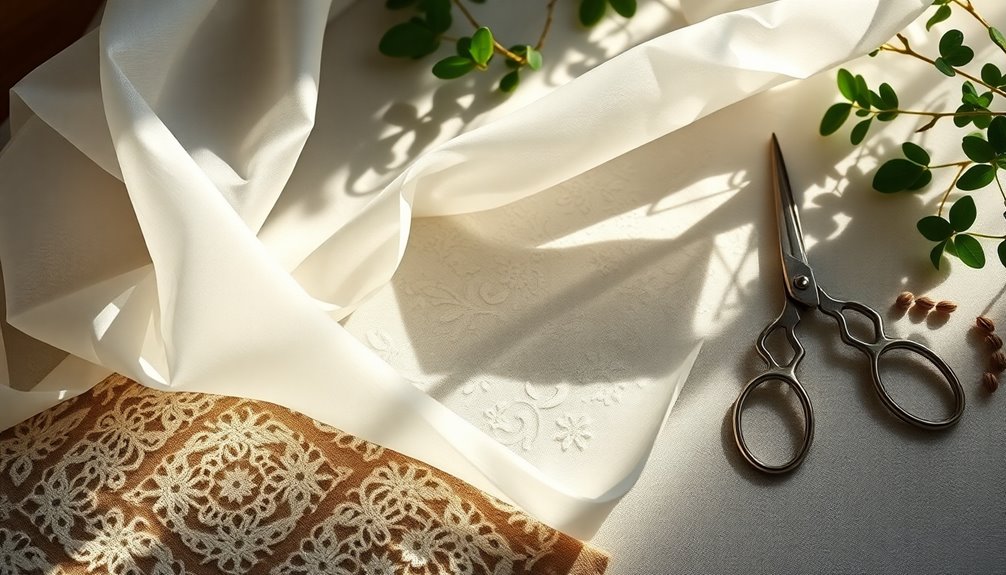
Acid-free tissue paper not only safeguards museum artifacts but also provides long-lasting protection for textiles. When you're storing valuable fabrics, using acid-free tissue paper is essential. This paper has a neutral pH level of 7 or higher, preventing yellowing and brittleness that can occur over time. By placing tissue paper for storing between layers of clothing, you protect delicate fabrics from abrasion and environmental damage, ensuring they remain pristine. Regular assessments of storage conditions can also help maintain optimal appliance health. Additionally, using acid-free tissue paper aligns with environmental sustainability practices by minimizing the potential for chemical damage to textiles. These protective qualities can be likened to the way Waldorf toys promote holistic development through careful material selection.
Buffered acid-free tissue paper is particularly effective for cotton and linen items, keeping them undamaged during long-term preservation. Unlike regular tissue paper, which often contains harmful acids that lead to deterioration, acid-free options are vital for heirloom preservation. They not only safeguard the integrity of your textiles but also prevent dye transfer, maintaining the original color and vibrancy of your garments.
When you choose acid-free tissue paper for storing your textiles, you're investing in their future. This simple yet powerful tool provides the cushioning and protection your items need to withstand the test of time, ensuring they remain cherished for generations to come. Additionally, using performance kits can enhance the durability of your storage solutions. Don't underestimate the importance of choosing the right materials for your valuable textiles.
Frequently Asked Questions
Why Is Acid-Free Paper Important?
Acid-free paper's important because it helps preserve your valuable items for the long haul. With a neutral pH, it prevents yellowing and brittleness that regular paper can cause over time. You won't have to worry about acid migration damaging your documents or artwork. By choosing acid-free options, you're ensuring that your precious photographs, textiles, and crafts stay vibrant and intact, making it a smart choice for anyone who values their collections.
Why Use Acid-Free Tissue Paper?
You should use acid-free tissue paper because it protects your valuable items from damage. Unlike regular tissue, it won't turn acidic over time, which helps prevent yellowing and brittleness in delicate materials like textiles and photographs. By cushioning these items, acid-free tissue minimizes abrasion during handling and storage, ensuring their longevity. Choosing the right weight and thickness tailored to your specific needs can make a big difference in preserving your cherished belongings.
How Can I Tell if My Tissue Paper Is Acid-Free?
To tell if your tissue paper is acid-free, check the packaging for the label "acid-free." This means it has a neutral pH of 7 or higher. If you want a quick test, use a pH testing pen; yellow or clear results indicate it's unsuitable. For more accuracy, consider using a pH meter. Remember, regular tissue papers often contain harmful acids and dyes, so always verify before using them for storage.
What Happens When Paper Is Not Acid-Free?
When paper isn't acid-free, it can cause serious damage over time. The acids in regular paper lead to yellowing and brittleness in your items, which means they'll lose their integrity. You might notice fading and crumbling, making your valuable textiles or documents unsuitable for display or preservation. This degradation process can happen faster than you'd think, leaving you with items that may become irreparably damaged and result in significant financial and sentimental loss.



